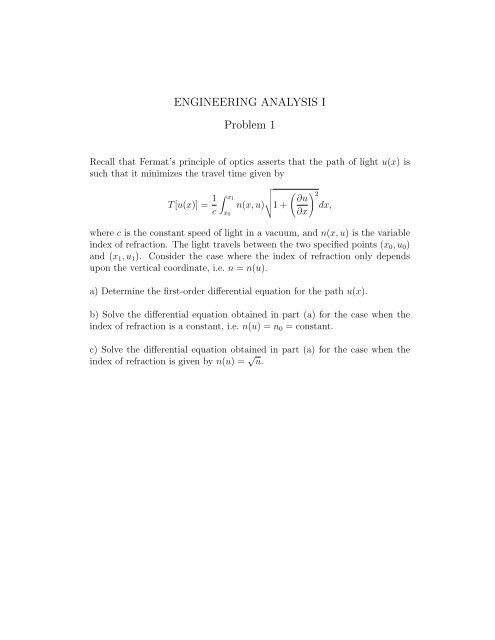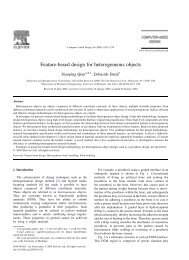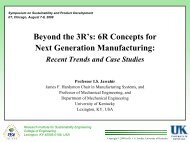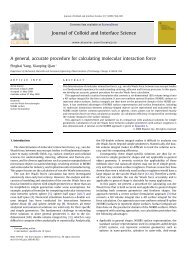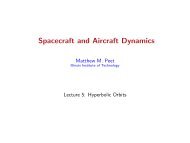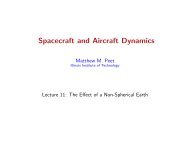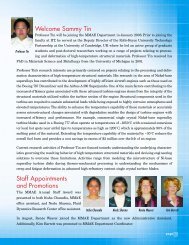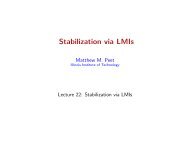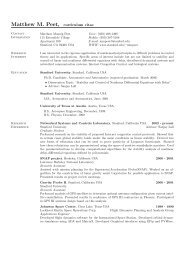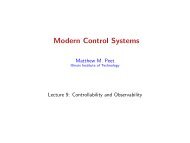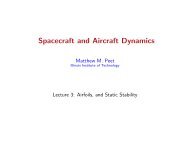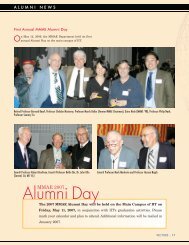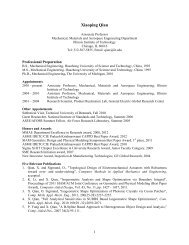Spring 2012 Sample Exam - Mechanical, Materials and Aerospace ...
Spring 2012 Sample Exam - Mechanical, Materials and Aerospace ...
Spring 2012 Sample Exam - Mechanical, Materials and Aerospace ...
You also want an ePaper? Increase the reach of your titles
YUMPU automatically turns print PDFs into web optimized ePapers that Google loves.
ENGINEERING ANALYSIS I<br />
Problem 1<br />
Recall that Fermat’s principle of optics asserts that the path of light u(x) is<br />
such that it minimizes the travel time given by<br />
T [u(x)] = 1 c<br />
( ) 2<br />
√ ∂u<br />
n(x, u) 1 + dx,<br />
x 0 ∂x<br />
∫ x1<br />
where c is the constant speed of light in a vacuum, <strong>and</strong> n(x, u) is the variable<br />
index of refraction. The light travels between the two specified points (x 0 , u 0 )<br />
<strong>and</strong> (x 1 , u 1 ). Consider the case where the index of refraction only depends<br />
upon the vertical coordinate, i.e. n = n(u).<br />
a) Determine the first-order differential equation for the path u(x).<br />
b) Solve the differential equation obtained in part (a) for the case when the<br />
index of refraction is a constant, i.e. n(u) = n 0 = constant.<br />
c) Solve the differential equation obtained in part (a) for the case when the<br />
index of refraction is given by n(u) = √ u.
ENGINEERING ANALYSIS I<br />
Problem 2<br />
Obtain the solution to the following system of differential equations using<br />
matrix operations<br />
dx 1<br />
dt = 2x 1 + 2x 2 ,<br />
dx 2<br />
dt = 2x 1 + 2x 2 ,<br />
subject to the initial conditions<br />
x 1 (0) = 1, x 2 (0) = 2.
ENGINEERING ANALYSIS II<br />
Solve the integral equation<br />
where a <strong>and</strong> b are constants.<br />
∫ t<br />
u(t) − a e −aτ u(t − τ)dτ = e −bt ,<br />
0
DYNAMICS I<br />
C<br />
p<br />
B<br />
d<br />
^<br />
b y<br />
è<br />
^<br />
b x<br />
^n y<br />
A<br />
R<br />
O<br />
^n x<br />
The unit basis ˆn x,y,z is fixed in a Newtonian reference frame. A circular disk of radius R <strong>and</strong><br />
mass M is able to rotate about the ˆn z direction without friction. A bead of mass m can move along<br />
a massless track at a distance d from O, the center of the disk, without friction. The massless track<br />
is oriented in the ˆb x direction, which is at an angle θ from the ˆn x direction. The bead is connected<br />
to point A on the disk via a massless spring with spring constant k. The unstretched length of the<br />
spring is AC, where C is the midpoint of AB. The distance from C to the bead is given as x. Use<br />
x <strong>and</strong> θ as generalized coordinates to position the disk <strong>and</strong> bead.<br />
1. Find the equation(s) of motion of the system.<br />
2. Locate the equilibrium position(s).<br />
3. Assume the disk is forced to rotate at a fixed angular velocity, ω, via an external torque about<br />
the disk’s axis. Derive an expression for the external torque necessary to keep ˙θ = ω. Hint:<br />
determine the external forces acting on the disk.<br />
4. Assume the disk is forced to rotate at a fixed angular velocity, ω, via an external torque about<br />
the disk’s axis. Find under what conditions the equilibrium point(s) of the system are stable.<br />
1
DYNAMICS II<br />
A thin disk B of radius r <strong>and</strong> mass m rotates with a constant angular rate ω relative to a<br />
hollow, massless arm A of length L. The arm A is pinned at point P to shaft S, which<br />
rotates with respect to an inertial frame about the vertical axis with constant rate Ω.<br />
(a) Find the equation of motion for θ.<br />
(b)<br />
It is given that given that L r = 3 2 , g<br />
! 2 r =1, <strong>and</strong> ! " = !1 .<br />
Find the non-zero equilibrium value of θ, <strong>and</strong> determine whether the system is<br />
stable at this equilibrium state.<br />
S<br />
Ω<br />
P<br />
g<br />
θ<br />
L<br />
A<br />
ω<br />
r<br />
B
Fluids Qualifying Problems <strong>Spring</strong> <strong>2012</strong><br />
Problem 1<br />
A Couette pump consists of a rotating inner cylinder <strong>and</strong> a baffled entrance <strong>and</strong> exit,<br />
as shown. Assuming zero circumferential pressure gradient <strong>and</strong> small gap over<br />
radius ratio, derive formulas for the volume flow <strong>and</strong> pumping power per unit<br />
depth. Calculate these values for 300 cSt (0.0003 m 2 /s) oil in the pump with a = 10<br />
cm <strong>and</strong> b = 9 cm when the pump is operated at 600 rpm.
Fluids Qualifying Problems <strong>Spring</strong> <strong>2012</strong><br />
Problem 2<br />
A viscous, incompressible liquid flowing down a vertical surface is shown in the<br />
figure. A boundary layer develops next to the vertical surface under the effects of<br />
gravity.<br />
a) Find an expression for the free-stream velocity U(x), assuming that U(x=0)=0.<br />
b) Write down the boundary-layer equations for this flow.<br />
c) From these equations obtain the corresponding momentum integral equations,<br />
<strong>and</strong> utilize an appropriate polynomial approximation to develop an expression<br />
for the boundary layer thickness (x).
A 2-D trough of semi-circular cross-section (i.e., a 2-D half-cylinder) has a radius R <strong>and</strong><br />
is irradiated on its convex side by a constant radiant heat flux q” convex . The trough’s<br />
concave side faces a matching 2-D lid with a grooved surface. The lid is positioned a<br />
distance h above the trough. The grooves in the lid run parallel to the axis of the trough<br />
<strong>and</strong> have width w, depth d, <strong>and</strong> separation pitch p. The surfaces of the lid not facing the<br />
trough are insulated. The ambient environment surrounding the lid <strong>and</strong> the trough is at<br />
temperature T ∞ .<br />
a) If trough has unspecified radiant properties <strong>and</strong> the grooves in the lid have a<br />
reflectivity ρ = 1, develop expressions for the temperature of the concave surface<br />
of the trough <strong>and</strong> its net radiant flux to the ambient environment using whatever<br />
additional assumptions you deem appropriate. Discuss how these quantities are<br />
influenced by the radiant properties of the trough’s concave surface <strong>and</strong> the<br />
geometry of the lid (w, d, p, h).<br />
b) Now assume that the grooves in the lid have emissivity ε ( > 0). Obtain<br />
expressions for the trough temperature <strong>and</strong> net radiant flux to the ambient<br />
environment using whatever additional assumptions you deem appropriate.<br />
Discuss how these values differ from those in a).<br />
c) If the number of grooves could vary as 2n, where n is a positive integer, discuss<br />
how the results of a) <strong>and</strong> b) would or would not be affected.<br />
d<br />
w<br />
Lid<br />
p<br />
h<br />
R<br />
Trough<br />
q” convex
Heat Transfer Qualifying Problems <strong>Spring</strong> <strong>2012</strong><br />
Problem 2<br />
An air jet, exiting from a round pipe, is impinging perpendicularly on a heated large but thin horizontal<br />
plate. The plate is heated with a heater (the same size as the plate surface) that is installed underneath<br />
the plate <strong>and</strong> it generates heat uniformly. The heater <strong>and</strong> the plate are perfectly insulated from below<br />
<strong>and</strong> the sides. The air exiting the pipe is at ambient temperature. Assume that the distance between<br />
exit of the pipe <strong>and</strong> the plate is H <strong>and</strong> the pipe diameter is D.<br />
a- Develop the governing equations <strong>and</strong> the boundary conditions for this problem that if solved,<br />
will provide the temperature distribution on the upper surface (facing the jet) of the plate.<br />
Clearly state all your assumptions. Do not solve the governing equations.<br />
b- Discuss how to determine the local convective heat transfer coefficient on the upper surface of<br />
the plate.<br />
Assume that the jet flow is laminar <strong>and</strong> steady. Clearly state all your assumptions.
PhD Qualifying <strong>Exam</strong> Questions<br />
Solid Mechanics – <strong>Spring</strong> <strong>2012</strong><br />
Problem 1. Given the homogeneous displacement field in a body<br />
0.06 0.05 0.01 <br />
0.01 0.03 <br />
0.02 0.01 <br />
mm<br />
mm<br />
mm<br />
(a) Calculate the strain field,<br />
(b) If there is a line segment 10 mmm long parallel to the axis in the undeformed geometry,<br />
what will be the new length of this line segment?<br />
(c) If there is a line segment 10 mmm long oriented at angles 40, 75 <strong>and</strong> 54 with the<br />
, <strong>and</strong> axes respectively in the undeformed geometry, calculate the new length of this<br />
line segment <strong>and</strong> also the rotation it undergoes after deformation,<br />
(d) Calculate the percent volume change of the body,
Problem 2. Stalactites hang from the ceilings in caves.<br />
They form as the dissolved salts get deposited over long<br />
periods of time. While the cross sections are usually<br />
arbitrary, we shall assume that they are circular, with a<br />
radius r varying with position x measured from the ceiling<br />
as illustrated in the figure. The objective is to determine an<br />
expression for the variation of the radius r(x). An<br />
intuitively appealing assumption on the survival of a<br />
stalactite is that everywhere in the stalactite the stress is<br />
uniform <strong>and</strong> equal to some value close to the breaking<br />
stress of the stone, o . Stalactites where the deposition is<br />
such that this is violated will fail.<br />
Take the mass density ρ of the stalactite as a constant<br />
everywhere.<br />
r(x)<br />
x<br />
Hint: Ignore higher order terms in the derivation of<br />
equilibrium equation (but do it carefully). In case you<br />
need, the volume of a truncated cone is given by<br />
<br />
3
MMAE569 PhD Qualifier <strong>Spring</strong> <strong>2012</strong><br />
Answer all parts of the question<br />
1. a) Define homogeneous <strong>and</strong> heterogeneous nucleation.<br />
b) Taking 108 J/m 3 as a typical value of the chemical free energy of a second phase<br />
particle, 1 J/m2 as the surface energy per unit area <strong>and</strong> neglecting any strain energy,<br />
calculate the radius of a spherical particle for which the surface energy is 1% of the<br />
chemical energy.<br />
c) Determine the degree of undercooling that would result in a chemical free energy of<br />
108 J/m3 assuming the Turnbull approximation:<br />
is valid <strong>and</strong> given that:<br />
latent heat of melting is 15000 J/mole<br />
Melting point is 727°C<br />
molar volume is 6.4x10 -6 m 3 /mole<br />
d) Using the triangular coordinate paper plot the following three phase field:<br />
composition 25%B, 10%C<br />
composition 55%B, 15%C<br />
L composition 25%B, 35%C<br />
e) Plot alloy X which has a composition of 35%B <strong>and</strong> 20%C. Determine the relative<br />
amounts of the , <strong>and</strong> L phases in alloy X.<br />
f) From the attached Ni-Cr-Ta isothermal section determine the following:<br />
i) the equilibrium phases in the alloy compositions 1 <strong>and</strong> 3.<br />
ii) The phase fractions in alloy 3<br />
f = 1- exp( -kt n<br />
)<br />
g) The JMA equation is:<br />
How would you plot a series of data of volume fraction transformed, f, versus time, t, to<br />
obtain the rate constant k <strong>and</strong> the time exponent n?
MMAE 468 Introduction to Ceramics<br />
Answer one question only<br />
QUESTION 1<br />
1. The ternary phase diagram for calcium aluminosilicate (CAS), calcium<br />
magnesium silicate (CMS), <strong>and</strong> manganese silicate(MS) is shown below.<br />
Answer the following questions based the ternary phase diagram<br />
How many binary eutectic points are there? Mark them BEx.<br />
What is the lowest binary eutectic temperature in the phase diagram?<br />
Mark the ternary eutectic point with a “TE”.<br />
What is the melting temperature of the ternary eutectic point?<br />
What is the bulk composition of the ternary eutectic?<br />
Mark the composition (40% CMS, 40% MS, 20% CAS) with an<br />
“X” on the phase diagram.<br />
What is the liquidus temperature for that composition?<br />
Mark the composition (20% CMS, 20% MS, 60% CAS) with a<br />
“Y” on the phase diagram.<br />
What is the liquidus temperature for that composition?<br />
QUESTION 2<br />
A high strength silicon nitride ceramic was produced with very fine (2 micron) starting<br />
powders <strong>and</strong> carefully sintered to produce a very well controlled grain size <strong>and</strong> flaw<br />
distribution. Tensile test specimens were prepared <strong>and</strong> then surface finish ground with a<br />
200 grit diamond wheel, perpendicular to the long axis of the test specimen.<br />
The mean room temperature tensile strength of a 200 grit ground silicon nitride specimen<br />
was measured as 280 MPa.<br />
SEM measurement gave a critical flaw size of 110 microns for this tensile specimen.<br />
With that 280 MPa tensile strength value <strong>and</strong> the 110 micron measured flaw size,<br />
what is the fracture toughness value ( K IC ) for this silicon nitride ?<br />
(Show your calculations <strong>and</strong> your units –
MMAE 554 Electrical Magnetic <strong>and</strong> Optical Properties of <strong>Materials</strong><br />
Open book<br />
Answer one question only<br />
1.. You are asked to produce a voltage of at least 15,000 volts using a PZT ceramic<br />
for which g33 = 0.025<br />
V.m/N. The PZT is available in the form of a bar with square cross-section, 1.0 mm on<br />
a side. The z axis is parallel to the long axis of the bar. A compressive force of 400N<br />
maximum along the z axis can be applied without crushing the PZT. What is the<br />
minimum length (in mm) for the PZT element?<br />
2. In the semiconductor indium phosphide (InP) Eg=1.30eV, the electron effective mass<br />
= 0.067 mo <strong>and</strong> the hole effective mass = 2.0 mo. How far above the top of the valence<br />
b<strong>and</strong> is the Fermi energy at 300K in intrinsic InP?<br />
(mo = actual rest mass of electron).
PhD <strong>Exam</strong> February 24, <strong>2012</strong><br />
Metallurgical <strong>and</strong> <strong>Materials</strong> Engineering Program S. Mostovoy<br />
Department of <strong>Mechanical</strong>, <strong>Materials</strong> <strong>and</strong> <strong>Aerospace</strong> Engineering<br />
1. Lightweight automobiles are being designed using high strength aluminum alloys. As an alternative to<br />
forming prior to heat treating, one of the techniques being considered is one where the alloy is shipped to the<br />
manufacturer in the fully heat-treated condition but then locally temporarily softened using high rate induction<br />
heating <strong>and</strong> water quenching (retrogression). It is found that a slower rate heating/cooling cycle does not give<br />
satisfactory softening/rehardening properties found using the induction treatment. In the flash heated <strong>and</strong><br />
quenched condition (optimum retrogression treatment) the alloy can be easily formed. After forming, the<br />
alloy regains it initial strength in less than an hour. If not worked, initial strength returns after about a week at<br />
room temperature (or several hours at 350°F). Detail the likely micromechanisms responsible for mechanical<br />
properties in each stage in the heat treatment <strong>and</strong> or working schedule. Use a phase diagram for a typical agehardenable<br />
alloy (e.g., 6061-T6) <strong>and</strong> a time-temperature-transformation sketch to illustrate these effects.<br />
Suggest a set of experiments that would provide optimum heat-treating, mechanical working <strong>and</strong> aging cycles<br />
for manufacture.<br />
2. Fracture Toughness<br />
The compliance versus crack length data for a 1 inch thick steel<br />
structure (σ o = 70 ksi; E = 30,000 ksi) is as shown in the table. The<br />
load applied to the structure in service is 10,000 lbs <strong>and</strong> the room<br />
temperature value for K IC is 40 ksi-√in. However service stresses<br />
range from -50°F to 400°F <strong>and</strong> the minimum flaw size detectable is<br />
0.4 inches.<br />
Crack<br />
Length a,<br />
inches<br />
Compliance, C, -<br />
10 -9 in/lb<br />
0.1 5.0<br />
0.2 10.0<br />
0.3 26.7<br />
A. Calculate the room temperature factor of safety <strong>and</strong> comment on<br />
0.4 35.6<br />
this value in light of the structure dimensions <strong>and</strong> the temperature<br />
range to which the structure is exposed.<br />
0.5 44.8<br />
0.6 53.3<br />
B. This structure may be exposed to high rate loading <strong>and</strong> it is<br />
proposed that a dynamic toughness criterion be used. Assuming<br />
0.7 80.0<br />
the curve for temperature versus K IC is available for this material <strong>and</strong> that the value of K IC at -50°F<br />
is known to be 20 ksi-√in. <strong>and</strong> the value of K IC is 100 ksi-√in. at 100°F; describe a procedure for<br />
estimating the critical value of toughness for high rate loading. Again, comment on the likely<br />
safety factor for this structure.
Design/Manufacturing (<strong>Spring</strong> <strong>2012</strong>)<br />
This is a closed-book, closed-notes exam. However, students are allowed to bring in one-sheet<br />
of equations.<br />
1 Bezier surface<br />
Derive the conditions for C 0 <strong>and</strong> C 1 continuity of a cubic Bezier composite surface of two patches.<br />
2 Bezier form of a curve on a given Bezier surface<br />
Consider a curve on a bi-quadratic Bezier surface S(u, v) =<br />
2∑<br />
i=0 j=0<br />
2∑<br />
P ij B i,2 (u)B j,2 (v).<br />
In the<br />
parametric (u, v) domain of the surface, this curve corresponds to a straight line between (0.25, 0.25)<br />
<strong>and</strong> (.5, .5). Find the Bezier form of this curve on the surface.<br />
1


